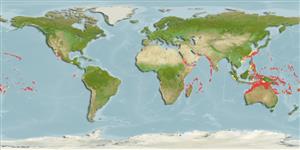Actinopterygii (ray-finned fishes) >
Anguilliformes (Eels and morays) >
Muraenidae (Moray eels) > Muraeninae
Etymology: Gymnothorax: Greek, gymnos = naked + Greek, thorax, -akos = breast (Ref. 45335).
Environment / Climate / Range
Ecology
Marine; reef-associated; depth range 2 - 271 m (Ref. 58302), usually 30 - ? m (Ref. 30404). Tropical, preferred ?; 30°N - 23°S
Indo-Pacific: Red Sea and Transkei, South Africa (Ref. 3257) to the Hawaiian and Marquesan islands, north to Ryukyu Islands, south to New Caledonia.
Size / Weight / Age
Maturity: Lm ? range ? - ? cm
Max length : 180 cm TL male/unsexed; (Ref. 9710)
Dorsal
spines
(total): 0;
Dorsal
soft rays
(total): 0;
Anal
spines: 0;
Anal
soft rays: 0. Large individuals; body dark yellow-brown numerous, smaller than pupil-sized spots that become small and numerous anteriorly, but large and widely spaced posteriorly (Ref. 48635). Yellow inside the mouth (Ref. 30404, 48635). This species has a relatively short, blunt snout; the larger specimens lack vomerine teeth and median intermaxillary teeth; the largest teeth are finely serrate; and jaws not arched, even in large specimens (Ref. 74922).
Mainly in oceanic locations (Ref. 48635); inhabits inner and outer reef slopes (Ref. 30404). Benthic (Ref. 58302). Mucus is toxic (Ref. 1602).
Life cycle and mating behavior
Maturity | Reproduction | Spawning | Eggs | Fecundity | Larvae
Chen, H.-M., K.-T. Shao and C.T. Chen, 1994. A review of the muraenid eels (Family Muraenidae) from Taiwan with descriptions of twelve new records. Zool. Stud. 33(1):44-64. (Ref. 6934)
IUCN Red List Status (Ref. 115185)
CITES (Ref. 94142)
Not Evaluated
Threat to humans
Poisonous to eat (Ref. 1602)
Human uses
Fisheries: of no interest; aquarium: commercial
More information
Common namesSynonymsMetabolismPredatorsEcotoxicologyReproductionMaturitySpawningFecundityEggsEgg development
ReferencesAquacultureAquaculture profileStrainsGeneticsAllele frequenciesHeritabilityDiseasesProcessingMass conversion
Tools
Special reports
Download XML
Internet sources
